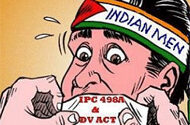Miscarriage of Criminal Justice System in India
This article is written by Vaasu Agrawal.
The emblem of justice denotes that law is blind in itself. Law, though, is of utmost importance and utility for society to ensure the well-being of mankind. But, as it appears to us, it has come under the grip of a hard-core powerful people who actually control the law per se, repetitively, the law is blind in itself, and thus this so-called powerful section considers itself to be above rule of law. These self-acclaimed godmen or conmen escape the consequence of trespassing the law very easily and thus it appears as if the law is just enforceable against the less powerful section of society. Such sort of hegemony results in drastic wrecks on the dignity of law especially in the eyes of common people. This article deals with the issue that how justice is a puppet of some people and how numerous times it is being misused and propelled against innocents and they got the title of “Convicted” from being accused within no time. Miscarriage of justice is not just confined to the financial status of people, it has several other dimensions too, such as gender and political status. It has been many a time when a man got convicted for a crime that he never committed just on the pretext of a false complaint by a woman.
As mentioned earlier, the consequences of a miscarriage of justice, especially criminal justice, are so drastic as it creates a sense of insecurity and disobedience in society. Dispensing justice is probably one of the toughest tasks. The apex court holds jurisdiction over the entire country and its verdict is non-challengeable and non-appealable. Thence the judiciary’s guardian i.e., The Supreme Court guarantees everybody’s right to justice and these miscarriages defeat this very aim of the judiciary.
Justice is very vulnerable and can be very easily triggered by many factors. Hasty decisions taken by the court many times, in order to clear out pending cases and plea bargaining in cases of personal grudges between the victim and accused, as the alleged accused could be threatened by the victim of false accusations which makes the accused accept the false allegations charged upon him/her. There are a lot of instances of Judicial Misconduct, or Corrupt Judges who are often bribed by either of the powerful party so as to dispose of the proceedings. This is just a sheer mockery of justice and has horrendous consequences on society per se.
With the advent of electronic media, though the delivery of news has become extremely fast but on the other hand, biased media houses tend to do an extra-judicial trial of an accused and portray him/her in such a way that the accused in most of the instances, is deemed to be a convict. Sunanda Pushkar’s case is one of the prominent examples of this stance, wherein Congress MP Shashi Tharoor seeks an injunction against Republic TV Editor, Arnab Goswami for broadcasting details of the death of Sunanda Pushkar. Added to that, Jasleen Kaur and Sarabjit Singh case is also one of the most highlighted benchmarks as Sarabjit Singh, the accused was harshly tried by media and how his entire life got messed up just because of false accusations by a girl. Moreover, corruption adorns such failures at the grass-root level. People having links and personal relations with politicians and highly powerful spokesmen, threaten the other party extra judicially. To sum up, there are a bulk of varied factors behind the setback to justice.
It is true that in a democracy, the judiciary cannot guarantee a person for justice. When an innocent is held as a convict for a crime, it becomes quite hectic and difficult for him to lead life in a way that he used to have before being convicted by the court. In such circumstances, where it is duly proven that an innocent was convicted for a crime which he never committed, it becomes the responsibility of the state to ensure that his living conditions get restored and provide incentives for the person and his kins.
When the rights of a person are violated and he/she consistently seeks justice, the person becomes mentally sick and feels harassed not only by the other party but also by the system itself. Nirbhaya Rape case (Mukesh and Anr. Vs State for NCT of Delhi &Ors[2]) is a well-known case in this regard where the victim’s family got justice after 7 years of crime committed when court-ordered death penalty of all the convicts. However, this highlights that there exists a number of loopholes in the judicial system as not all rape cases got the support and sympathy as Nirbhaya’s case.
Though, over the years steps have been taken by the state in this regard and addressed by the courts as well. With respect to the financial burden, free legal aid is provided to the parties, not only for the prosecution but for the respondent as well. Lok Adalats which don’t have any extra court fee and are meant for speedier proceedings also work for dispensing justice.
Curative Petition
It was in the case of Rupa Ashok Hurra V. Ashok Hurra and Anr. [3]where the Supreme Court adopted a curative petition for the first time in order to prevent the occurrence of a miscarriage of justice. The court, in this case, has ruled that that curative petition can only be filed if the petitioner in the case can prove that there has been a contravention with the principles of natural justice. Along with this the burden of proving that the court was ignorant of the presence of curative petition while passing the verdict rests on the petition as well.
Although curative petitions are taken under concern in exceptional cases being observed in open court hearings, it is one of the instruments of eliminating miscarriage of justice from occurring along with providing restrictions on the abuse of the power of the courts. The suffered party has a legal right to file an appeal to the court for reviewing its judgment for the second time in a row which must be made by following the rules as has been laid down by the court.
Judicial Review
It is unarguably true that miscarriage of justice does not always occur through the verdicts of the courts, but can also result from the influence of the legislature and the executive pillars of the government. Several instances have occurred which proves that the influence of the executive and the statutes framed by the legislatures can put the judiciary in a dilemma as to what verdict is to be declared. Going by the safe side, the courts often fail to follow the path of justice and subsequently, leads to miscarriage of justice. In order to negate the same, the power of judicial review is provided to the judiciary so that the Constitutional validity of any statute may be checked and approved by the lordships.
Curated by Kavana Rao, Symbiosis Law School, Noida
References
https://blog.ipleaders.in/recent-instances-miscarriage-justice/
[1] Justice here implies righteousness.
[2] Mukesh &Anr. v. State for NCT of Delhi &Ors., (2017) 6 SCC 1
[3] 1999 SC 2870, (1999) 2 SCC 103


